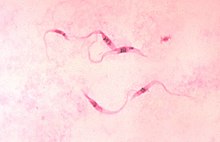| Excavata | |
|---|---|
 | |
| Intervallo geologico | |
| Classificazione filogenetica | |
| Dominio | Eukaryota |
| (clade) | (sottodominio) Bikonta |
| (clade) | (supergruppo) Excavata |
| Classificazione classica | |
| Dominio | Eukaryota |
| Regno | Protista |
| Sottoregno | Excavata |
| Phylum (classica) | |
| Regni (filogenetica) | |
Excavata è un importante supergruppo del sottodominio Bikonta (l'altro è Eubikonta), costituito da organismi unicellulari appartenenti al dominio Eukaryota.[1][2][3]
È stato suggerito per la prima volta da Simpson e Patterson nel 1999[4][5] e introdotto da Thomas Cavalier-Smith nel 2002 come taxon formale. Contiene una varietà di forme simbiotiche e libere e include anche alcuni importanti parassiti umani, tra cui Giardia e Trichomonas.[6] Gli excavata erano precedentemente inclusi nell'ormai obsoleto regno dei Protisti.[7] Sono classificati in base alle loro strutture flagellari,[5] e sono considerati il lignaggio flagellato più basale.[8] Le analisi filogenomiche hanno diviso i membri di Excavata in tre gruppi diversi e non tutti strettamente correlati: Discoba, Metamonada e Neoluka.[9][10][11] Fatta eccezione per Euglenozoa, sono tutti non fotosintetici.
- ^ V. Hampl, L. Hug, J. W. Leigh, J. B. Dacks, B. F. Lang, A. G. B. Simpson e A. J. Roger, Phylogenomic analyses support the monophyly of Excavata and resolve relationships among eukaryotic "supergroups", in Proceedings of the National Academy of Sciences, vol. 106, n. 10, 200.9, pp. 3859–3864, Bibcode:2009PNAS..106.3859H, DOI:10.1073/pnas.0807880106, PMC 2656170, PMID 19237557.
- ^ Hampl V, Hug L, Leigh JW, Phylogenomic analyses support the monophyly of Excavata and resolve relationships among eukaryotic "supergroups", in Proc. Natl. Acad. Sci. U.S.A., vol. 106, n. 10, 2009, pp. 3859–64, Bibcode:2009PNAS..106.3859H, DOI:10.1073/pnas.0807880106, PMC 2656170, PMID 19237557.
- ^ Simpson, Ag, Inagaki, Y e Roger, Aj, Comprehensive multigene phylogenies of excavate protists reveal the evolutionary positions of "primitive" eukaryotes, in Molecular Biology and Evolution, vol. 23, n. 3, 2006, pp. 615–25, DOI:10.1093/molbev/msj068, PMID 16308337.
- ^ (EN) Alastair G.B. Simpson e David J. Patterson, The ultrastructure of Carpediemonas membranifera (Eukaryota) with reference to the 'excavate hypothesis', in European Journal of Protistology, vol. 35, n. 4, Dec 1999, pp. 353–370, DOI:10.1016/S0932-4739(99)80044-3.
- ^ a b (EN) Alastair G.B. Simpson, Cytoskeletal organization, phylogenetic affinities and systematics in the contentious taxon Excavata (Eukaryota), in International Journal of Systematic and Evolutionary Microbiology, vol. 53, n. 6, 1º novembre 2003, pp. 1759–1777, DOI:10.1099/ijs.0.02578-0, ISSN 1466-5026, PMID 14657103.
- ^ Richard Dawkins e Yan Wong, The Ancestor's Tale, 2016, ISBN 978-0544859937.
- ^ T Cavalier-Smith, The phagotrophic origin of eukaryotes and phylogenetic classification of Protozoa., in International Journal of Systematic and Evolutionary Microbiology, vol. 52, n. 2, 2002, pp. 297–354, DOI:10.1099/00207713-52-2-297, PMID 11931142.
- ^ Scott C Dawson e Alexander R Paredez, Alternative cytoskeletal landscapes: cytoskeletal novelty and evolution in basal excavate protists, in Current Opinion in Cell Biology, vol. 25, n. 1, 2013, pp. 134–141, DOI:10.1016/j.ceb.2012.11.005, PMC 4927265, PMID 23312067.
- ^ MW Brown, AA Heiss, R Kamikawa, Y Inagaki, A Yabuki, AK Tice, T Shiratori, KI Ishida, T Hashimoto, AGB Simpson e AJ Roger, Phylogenomics Places Orphan Protistan Lineages in a Novel Eukaryotic Super-Group., in Genome Biology and Evolution, vol. 10, n. 2, 1º febbraio 2018, pp. 427–433, DOI:10.1093/gbe/evy014, PMC 5793813, PMID 29360967.
- ^ Aaron A. Heiss, Martin Kolisko, Fleming Ekelund, Matthew W. Brown, Andrew J. Roger e Alastair G. B. Simpson, Combined morphological and phylogenomic re-examination of malawimonads, a critical taxon for inferring the evolutionary history of eukaryotes, in Royal Society Open Science, vol. 5, n. 4, 4 aprile 2018, pp. 171707, Bibcode:2018RSOS....571707H, DOI:10.1098/rsos.171707, PMC 5936906, PMID 29765641.
- ^ PJ Keeling e F Burki, Progress towards the Tree of Eukaryotes., in Current Biology, vol. 29, n. 16, 19 agosto 2019, pp. R808–R817, DOI:10.1016/j.cub.2019.07.031, PMID 31430481.
